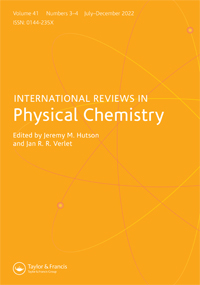水溶液电荷注入:溶剂化键动力学,分子非键相互作用,和非凡的溶质能力
IF 2.5
2区 化学
Q3 CHEMISTRY, PHYSICAL
引用次数: 26
摘要
水溶液中电子、质子、孤对、离子和分子偶极子等形式的溶剂化电荷注入对我们的健康和生活有着无处不在的重要意义。追求精细分辨率检测和对溶剂化动力学和溶质能力的一致见解已经成为一个日益活跃的主题。本文表明,溶剂化作用下的电荷注入通过O:H形成、H↔H破碎、O:⇔O压缩、静电极化、H2O偶极屏蔽、溶质-溶质相互作用和欠协调的H - O键收缩介导了O:H - O键网络和溶液的性质。氢键(O: H-O或HB, ': '为氧的电子孤对)协同性概念与差分声子光谱(DPS)的结合,使以下方面的定量信息成为可能:(i) HBs从普通水模式转变为水化模式的数量分数和声子刚度;(ii)溶质-溶剂和溶质-溶质分子非键相互作用;(3)表面应力、溶液粘度、分子扩散率、溶剂化热力学以及相变的临界压力和温度的相互依赖性。对溶剂化动力学的研究阐明了以下几点:(i)过量的质子产生H↔H或抗hb点破断,破坏酸性溶液网络和表面应力。(ii)过量的孤对产生O:⇔:O或超hb点压缩器,在H2O2和碱性溶液中缩短O:H非键,延长H - O键;然而,由于H2O2和OH -溶质的存在,键序缺陷使氢氧键缩短和变硬。(iii)离子作为电荷中心,使相邻的HBs排列、聚集、拉伸和极化,形成水合壳。(iv)醇、醛、络合盐、羧酸和甲酸、甘氨酸和糖的溶剂化会使抗hb或超级hb的参与使溶质-溶剂界面结构扭曲。将知识和策略扩展到催化,溶液-蛋白质,药物-细胞,液-固,胶体-基质相互作用和分子晶体将更加令人着迷和有益。本文章由计算机程序翻译,如有差异,请以英文原文为准。
Aqueous charge injection: solvation bonding dynamics, molecular nonbond interactions, and extraordinary solute capabilities
ABSTRACT Aqueous charge injection in forms of electrons, protons, lone pairs, ions, and molecular dipoles by solvation is ubiquitously important to our health and life. Pursuing fine-resolution detection and consistent insight into solvation dynamics and solute capabilities has become an increasingly active subject. This treatise shows that charge injection by solvation mediates the O:H–O bonding network and properties of a solution through O:H formation, H↔H fragilization, O:⇔:O compression, electrostatic polarization, H2O dipolar shielding, solute–solute interaction, and undercoordinated H–O bond contraction. A combination of the hydrogen bond (O:H–O or HB with ‘:’ being the electron lone pairs of oxygen) cooperativity notion and the differential phonon spectrometrics (DPS) has enabled quantitative information on the following: (i) the number fraction and phonon stiffness of HBs transiting from the mode of ordinary water to hydration; (ii) solute–solvent and solute–solute molecular nonbond interactions; and (iii) interdependence of skin stress, solution viscosity, molecular diffusivity, solvation thermodynamics, and critical pressures and temperatures for phase transitions. An examination of solvation dynamics has clarified the following: (i) the excessive protons create the H↔H or anti-HB point breaker to disrupt the acidic solution network and surface stress. (ii) The excessive lone pairs generate the O:⇔:O or super–HB point compressor to shorten the O:H nonbond but lengthen the H–O bond in H2O2 and basic solutions; yet, bond-order-deficiency shortens and stiffens the H–O bond due H2O2 and OH− solutes. (iii) Ions serve each as a charge center that aligns, clusters, stretches, and polarizes their neighboring HBs to form hydration shells. (iv) Solvation of alcohols, aldehydes, complex salts, carboxylic and formic acids, glycine, and sugars distorts the solute–solvent interface structures with the involvement of the anti-HB or the super-HB. Extending the knowledge and strategies to catalysis, solution–protein, drug–cell, liquid–solid, colloid–matrix interactions and molecular crystals would be even more fascinating and rewarding.
求助全文
通过发布文献求助,成功后即可免费获取论文全文。
去求助
来源期刊
CiteScore
14.20
自引率
1.60%
发文量
5
审稿时长
1 months
期刊介绍:
International Reviews in Physical Chemistry publishes review articles describing frontier research areas in physical chemistry. Internationally renowned scientists describe their own research in the wider context of the field. The articles are of interest not only to specialists but also to those wishing to read general and authoritative accounts of recent developments in physical chemistry, chemical physics and theoretical chemistry. The journal appeals to research workers, lecturers and research students alike.

 求助内容:
求助内容: 应助结果提醒方式:
应助结果提醒方式:


